 | ||
Orkney islands the old man of hoy
The Old Man of Hoy is a 449-foot (137m) sea stack on the island of Hoy, part of the Orkney archipelago off the north coast of Scotland. Formed from Old Red Sandstone, it is one of the tallest stacks in Britain. The Old Man is popular with climbers, and was first climbed in 1966. Created by the erosion of a cliff through hydraulic action some time after 1750, the stack is no more than a few hundred years old, and may soon collapse into the sea.
Contents
- Orkney islands the old man of hoy
- Map of Old Man of Hoy Stromness UK
- Old man of hoy venture episode 1
- Geography
- Geology
- History
- Climbing
- BASE jump
- References
Map of Old Man of Hoy, Stromness, UK
Old man of hoy venture episode 1
Geography
The Old Man stands close to Rackwick Bay on the west coast of the island of Hoy, in the Orkney Islands, Scotland, and can be seen from the Scrabster to Stromness ferry. From certain angles it is said to resemble a human figure.
Winds are faster than 8 metres per second (18 mph) for nearly a third of the time, and gales occur on average for 29 days a year. Combined with the depth of the sea, which quickly falls to 60 metres (200 ft), high-energy waves on the western side of Hoy lead to rapid erosion of the coast.
Geology
The Old Man of Hoy is a red sandstone stack and perched on a plinth of basalt rock. It is separated from the mainland by a 60-metre (200 ft) chasm strewn with debris, and has nearly vertical sides with a top just a few metres wide. The rock is composed of layers of soft, sandy and pebbly sandstone and harder flagstones of Old Red Sandstone, giving the sides a notched and slab-like profile.
History
The Old Man is probably less than 250 years old, and may soon collapse. The stack is not mentioned in the Orkneyinga saga, written c.1230, and on the Blaeu map of 1600, a headland exists at the point where the Old Man is now. The McKenzie map of Hoy of 1750 similarly shows a headland but no stack, but by 1819 the Old Man had been separated from the mainland. William Daniell sketched the sea stack at this time as a wider column with a smaller top section and an arch at the base, from which it derived its name.
Sometime in the early nineteenth century, a storm washed away one of the legs leaving it much as it is today, although erosion continues. By 1992 a 40-metre (130 ft) crack had appeared in the top of the south face, leaving a large overhanging section that will eventually collapse.
Climbing
The stack was first climbed by mountaineers Chris Bonington, Rusty Baillie and Tom Patey in 1966. From 8–9 July 1967, an ascent featured in The Great Climb, a live BBC three-night outside broadcast, which had around 15 million viewers. This featured three pairs of climbers: Bonington and Patey repeated their original route, whilst two new lines were climbed by Joe Brown and Ian McNaught-Davis and by Pete Crew and Dougal Haston.
Red Szell became the first blind person to climb the Old Man, despite suffering from retinitis pigmentosa that left him with 5 per cent vision. With assistance from Martin Moran and Nick Carter, he scaled the stack in 2013.
There are seven routes up the stack, the most commonly used of which is the original landward facing E1 (Extremely Severe). A log book in a Tupperware container is buried in a cairn on the summit, as an ascensionists' record. As many as fifty ascents of the stack are made each year.
BASE jump
Roger Holmes, Gus Hutchinson-Brown and Tim Emmett made the first BASE jump from the stack on 14 May 2008. Hutchinson-Brown died 11 days later during a jump in Switzerland.
